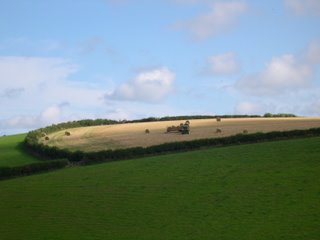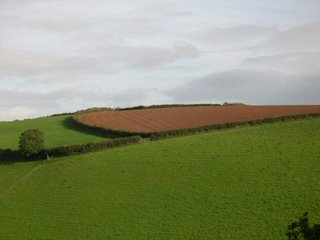
I have been home for over a week now. How have I spent my time? I made cheese, of course!
I came home and went right to work. I had to make sure I remembered everything that I learned while in Devon.
Before I could make cheese, I needed to consider how I might age it. I can't just leave it out for the cats to sniff, and it needs to be kept in a cool, humid environment. I need a cheese cave.
I lack anything close to cave like conditions in my Sunset District home. They don't build basements in homes built on ancient sand dunes. Like most American homeowners, I DO have an extra fridge in the garage. When we remodeled our kitchen, the old fridge went to live downstairs, just inside the garage. Jim claimed it as his beer and soda fridge. During the holidays it masquerades as a legitimate refrigerator. Well my plans now include putting this extra power drain to good use. A few months ago I bought a device that overrides the refrigerator's thermostat and raised the operating temperature to proper cave temperature. Most fridges don't like to hang out at 50-55 degrees. So I plugged the gizmo in and put copper sensor rod in the fridge. I monitor the temp inside the fridge via a thermometer that registers temps as well as humidity. Now I'm playing with pans of water in the fridge to keep the humidity up. A fridge is a natural dehydration chamber, so keeping water in something that lets it evaporate into the air in it is critical for proper cheese maturation.
Jim came home, went into the garage to start a load of laundry and came upstairs with a puzzled look. "What did you do to the fridge?" he asked. He's quick, I'll give him that. I know he knew the answer, but I humored him. I gave him a big smile and said, "I converted it into a cheese cave."
Pause.
"Oh," he said. "What about the stuff in the fridge?"
"It's only soft drinks and beer. They can stay in there so long as I'm not aging cheese. They'll be kept a bit warmer, that's all," I said trying to comfort him. "And besides, you wanted to get rid of it."
"But that was before I put beer and soft drinks in there." He just shook his head and knew he couldn't win this conversation. I now have my cheese cave.
Back to the cheese. I got home on Wednesday. Thursday was spent doing laundry and shopping. I had to restock our real refrigerator. Wednesday night I discovered a roasted chicken breast that was left over from a meal five weeks ago. It had turned blue and smelly. Toss. I also tossed a few other nasty looking specimens. I guess Jim didn't go through the fridge while I was away. Off to the Serramonte Farmer's Market on Thursday. Stocked up on good fruit and veggies. Also made a Trader Joe's stop and got some goat milk. They carry a brand that's NOT ultra-pasteurized. Critical for cheesemaking.
Friday I made cheese. I tried to do a modified Ticklemore Goat. It is hard to replicate the conditions of the make room and aging rooms at Ticklemore because I can't just throw water on the floor and have the room temperature kept at appropriate aging temps. I've got to live here! So I dry the young cheese in the kitchen and then moved it to the cooler office downstairs. I put it into a large cardboard box to keep the humidity up. I also have placed a couple of clean, wet cloths in cups of water to wick up moisture and release it into the box as well. Hopefully this will keep the air humid enough for my cheese.
The photo above shows it when it was a few hours old. The image below is the cheese at one week of age. We have achieved fuzz! P. Candidum to be exact. Three more weeks to go! The cheese went into the cave yesterday.
My other project: I'm starting to write a business plan. Gotta get these ideas out of my head and onto the illuminated page.
Friday, September 29, 2006
One week hence
Posted by
Sairbair
at
4:40 PM
0
comments
![]()
Labels: Ticklemore Cheese Devon England
Thursday, September 21, 2006
Wednesday, September 20, 2006
I'm leaving on a jet plane
Sitting at Heathrow, waiting for them to call my flight. Said goodbye to Amy at the Garden Court Hotel. She's from New Zealand and moved to London last year in order to earn some good old Sterling. Nice person. She wants to be an interior decorator and is trying go figure out whether or not to study in London or back in New Zealand. She took my cheese and put it in the fridge overnight. Now it stands a chance of making it home in good shape. Fingers crossed.
For future reference, when you're standing on a main artery to Paddington Station at 10am, forget trying to hail a taxi. It just doesn't happen. Stood there waving my arms, trying to hail a cab for 20 minutes. This is London for crying out loud! There are a million taxis. Just not when I need one. I wound up taking the bus to Paddington. Fortunately, it wasn't far and I still had money on my Oyster Card (bus/Tube pass.) It was just a pain with my VERY heavy luggage. I swear, they pick up weight as if by magic. Too many gifts and too much cheese, I guess.
I'm eager to see the wild terrain of California. I am amazed at how well manicured the English landscape is. It has been occupied for so many eons that every square inch seems to have had some form of alteration from man. The stone hedges, most trees grow along side the hedges, out of the way of a plow, the miles of public footpaths, even the forests are all planned and accounted for. Just look at an Ordinance Survey Map and you'll see what I mean. I know parts of Wales and Scotland are a bit more wild, but for most of Britain, it's very well maintained. Given that half of the population of Great Britain lives in rural countryside or villages, I'm not surprised, I guess.
I wonder what the guys at Ticklemore are doing today. Normally they're off on Wednesdays, but Liz is away this week. They called Will up from the cheese shop to lend a hand, but Either Nick or Ben must work today. I wonder who drew the short straw?
Now it's up to United Airlines to make sure I arrive home safe and sound. I can't wait to see the smile on Jim's face as I emerge from the hermetically sealed environment of US Customs in San Francisco. I've missed him. I should be home in about 12 hours.
Posted by
Sairbair
at
4:43 AM
0
comments
![]()
Labels: Ticklemore Cheese Devon England
Tuesday, September 19, 2006
Insert your cheesy farewell song here....

Leaving Totnes.
I woke up to a beautiful, sunny morning, A nice way to remember this place. My B & B is situated off of Totnes Down Hill Road; the road that goes past Ticklemore. Dart Villas is just above the roofline of the buildings so it has a spectacular view of the river, most of Totnes and the fields beyond the town. I had the Garden Room. It overlooks the terraced garden in back. My room was bright and clean. I watched birds flitting around the feeders and butterflies going from flower to flower. It was nice to unwind and reflect on my experiences at Ticklemore in this room. I'm still a bit choked up. I don't like leaving such a wonderful place. I could not have predicted how well things went. I know I'm being silly, but I had a truly magical time here.
The breakfast was great. Organic scrambled eggs, sautéed mushrooms with garlic and homegrown tomato, grilled, served with fried bread. Scrumptious! I met two other women staying at Dart Villas. One lives on the South Island of New Zealand and is visiting her daughter. The other was in town for a class at Buckfast Abbey. We chatted for a while. Very pleasant women.
I packed up and settled my tab. I dragged my heavy luggage down the steps and waited for Robin to pick me up. The sun and gentle breeze felt good. I was happy to be out in the fresh air. Robin showed up with the van and we chatted all the way to the train station. I'm free to ask him any questions and wished me the best of luck back home.
We drove through town and he dropped me off at the station. A quick hug and off he went, back to Ticklemore. The train pulled up promptly and I climbed aboard. I watched Totnes recede though the glass and fought back more tears. Time to go home.
I'm in London now. The air is filthy. It's noisy and crowded. Everyone is in a hurry. No one smiles. My hotel is nice. I'm back at the Garden Court Hotel. Jim and I stayed here in June. I have the same room as before, 107. Amy the Kiwi is behind the desk.
What did I do after I checked in? I still have an Oyster Card with cash on it so I'm ready to go! I walked out of my hotel and caught the Number 7 bus on the corner and went to Tottenham Court Road. I wandered over to Neal's Yard Dairy. Sam and Zack were behind the counter. Big friendly greeting. I spent an hour just chatting and eating cheese. Old habits are hard to break. Yeah, I bought some, too. Hope it survives. Did some shopping in the neighborhood. Does cheese make a good birthday present? We'll find out. I'm kidding Jim! The cheese is for me. I'll share.
Bus back to the hotel. Easier than taking the Underground at rush hour. I go back to my room and relax for a while. Dinner at Nando's Chicken. Yes! I love that Portuguese grilled chicken. It is cheap and bountiful. Jim and I always go to Nando's. There is a location a block away from the Garden Court Hotel. The lazy person's dream dinner.
Gotta catch a plane from Heathrow tomorrow. Never fun under normal circumstances.
Home again.
Where do I go from here?
I'm a bit nervous and scared. My next move is uncharted. I don't know where I'll be in a year, I don't know what I'm doing next week. I have a few options. I'd like to visit more cheesemakers and see other facilities. I'd like to go scouting for property. I can start writing a business plan. I can talk to the Cowgirls and see if they're willing to share some of their wisdom. ( I like this ideal.) I can experiment with cheese in my kitchen. (I like this one, too.) It is time to purge the crap in the garage. Time for a yardsale!
It is all up to me now. I've just got to decide what I want to do and go for it. Let me just close my eyes while I jump into the void.
Oh, and I need a name for my cheese.
Posted by
Sairbair
at
3:00 PM
1 comments
![]()
Labels: Ticklemore Cheese Devon England
Saying goodbye
 The merry men of Ticklemore. Robin Congdon, Ben Harris, and Nick Trant. They're nice when you get to know them.
The merry men of Ticklemore. Robin Congdon, Ben Harris, and Nick Trant. They're nice when you get to know them.
The curtains are closing on the month long play. Time to turn the lights off and head for home.
Last day today. I'm very sad to be leaving. I've really had a wonderful time. These guys are great. I feel like the baby bird being tossed out of the nest. I don't want to leave the nest! It's comfortable. I like it here. I want to keep doing what I'm doing. It agrees with me. I didn't think I'd fall into such a good place. That lonely, windy spot on the side of the hill is where my dreams came to fruition. I've dreamed of making cheese. I asked if they'd let me learn how to make cheese with them. They said yes. I left my husband and my home for a month. I lived by myself and worked closely with Nick Trant and Ben Harris. They guided me patiently through the steps they take to produce some of the finest cheeses in the world. I was trusted with the knowledge and the cheese cutter. I feel like I really made a connection with these guys. I count them as my friends. I will forever be thankful to them for taking the time to show me the ropes and letting me into their lives. Especially Nick. He really made an effort to ensure that I was OK, invited me to his home, introduced me to his wife and kids, and even gave me fish and pheasant.
I was glad I worked at Ticklemore today. I had the option to not go in since Robin and Sarie have returned. The day began per usual for a Monday. I spiked 71 cheeses. Two batches of Devon Blue and one of Harbourne went into the cave. Nick banged out all cheese that needed salting. I get salt in my gloves when I salt a lot of cheese. Salt plus sweat in gloves equals a rash on my skin. I have very sensitive skin, not a good thing in this business.
Tea time was bittersweet for me. The dynamic changed. I was feeling sad and the guys were feeling on edge since the boss was home. Robin wasn't there as he had gone off to pick up the goat milk from Button Farm. Robin spent most of the day going through the mail and catching up on invoices. He never entered the dairy. We scraped a couple of batches of Devon Blue and Harbourne before and after lunch. They were wrapped in cling film and placed in the cold room to let them mature.
At lunch we were unusually quiet since Robin was at the table. Robin talked about his stay in Spain. I looked at photos, but I mostly just stared at my peanut butter and jelly sandwiches. Silly me forgot to grab an apple from my stash at my B & B. I did have some raspberries that I kept in their fridge. Light lunch.
I took even more photos and Nick let me cut and stir the Ticklemore Goat. The trick is not following the recipe to a T, but to get the timing right and learning how to read the curds. With Ticklemore Goat, if the curds are throwing off a lot of whey, they need less handling, stir them less. Stir more, if you need to firm them up, but not too firm. Devon Blue can be altered by adjusting how fine the curd is cut. The fat and protein content of the milk is always changing, so with experience the true knowledge is gained. Ben and Nick were happy I stayed an extra day to work with them. They appreciated the extra hands. Robin was happy I wanted to work in the dairy so he could weed through the pile of papers stacked on his desk.
I am leaving with small Baby Boyton, double wrapped and vacuum sealed. Sarie is cutting a quarter wheel of Harbourne Blue for me. Robin will wrap it and I'll carry it home in a cooler bag placed in my luggage. Hopefully it will make the journey safe and sound. I hope to share it with family and friends. Cheese party anyone?
Nick sent me inside to debrief with Robin while Ben and he cleaned up in the dairy. I went into the living room and Robin was on the phone. I went into the bathroom and changed. Sarie was at the cheeseshop. When I emerged in my street clothes, Robin was off the phone. He asked how it went. "Did I learn anything?" "Yeah. One or two things," I replied, smiling. I thanked him again for giving me this opportunity. "It worked out well for both of us," he said. They got a house sitter, and I got to immerse myself in the daily life of a cheesemaker in Totnes. It's a big win-win situation. Robin has been making cheese for so long that it is just second nature to him. He's quick to offer pearls of wisdom and suggestions. He said to email or call whenever I have any questions. I said to give me ring whenever they need a house sitter again! Maybe next time, Jim can join me. There is so much I want to share with him. Photos can't convey enough.
I kept a stiff upper lip when I hugged Ben and Nick and wished them farewell. They're a great couple of guys. I hope to see them again someday. I'd love to work with them again.
Liz agrees with me. It was good for me to stay at the Dairy and get my feet wet on a trial basis. I didn't have to start making my own cheese to see if I liked doing it. I got a trial run, living in a remote place, tending to the daily requirement of cheesemaking and, making friends with the house spiders and local farm cats. I really like this simpler way of living. The Devon country life is very attractive. Robin and Sarie live without a lot of excessive baggage. They don't have any clutter. Hell, they don't even have a frying pan.
Lessoned learned: I will not live in the same building where I make cheese. Walking distance is fine, thanks. My break room will not be my living room. I will have a clothes washer AND a dryer. I will have a pasteurizer that's not homemade; mine will be easier to clean. I will have a round vat for my version of Ticklemore Goat, but I might install a paddle with a timer to gently stir the curds. My making and draining tables will be of a good height for me. I will have room to walk all the way around the vats and tables. I will have two cheese caves if I am working with blue and white molded cheese. My cheese will be easy to reach in my cave. I will try to make the procedures as ergonomic as possible. I will turn my cling film wrapped cheese a couple of times while waiting for it to ripen. Use long gloves so salt does not get inside.
Tomorrow their day will go on as usual, but I'll be flying back to my life in the States. But my life is forever changed. I am a cheesemaker, I'm ready to continue my education, but I've got a better feel for what to expect. This path is leading me to a new adventure as a small business owner, as an artisan and as an alchemist turning milk (lead) into cheese (gold.)
This month has just flown by. I can't believe I left San Francisco a month ago. I am also thankful that I have a wonderful and dear husband who has been totally supportive of my wild and crazy ambitious dreams. It helps that we came here for a day in May, he met the people and saw the set up. We were both assured that this was a good idea. I'm sure that I could have found a someplace closer to home, but that wasn't the point. My goal was to work with people making a cheese I enjoy, and were willing to take me in hand and show me everything. Complete and total immersion. I got that and more. I have fallen in love. I'm in love with making cheese. I'm in love with a "lifestyle" career that is totally my choice, and of my creation. I hope Jim knows what he's in for.
Posted by
Sairbair
at
2:54 PM
0
comments
![]()
Labels: Ticklemore Cheese Devon England
Wrap it up, clearing out.
Sunday, September 17, 2006
I wake up to pouring rain. Ugh. I stayed up too late packing and cleaning. I've made a long list of things to do before I vacate the Dairy. First order of business, strip the bed and start the laundry. Then I start the Sunday Morning Routine in the Dairy. I unlock the door and get right down to business. This is my third time doing it. I've got it down, now. I get it all done in 2 ½ hours and lock up. Again, I'm sad. There is a sense of finality to everything I do. But I can't think about that right now. I've got to vacuum, change the bed, toss groceries, and throw my bags in the van. I cross each task off of my list and in an hour I'm ready to go. OK.
Fall is in the air. The rain has subsided and I can see a few patches of blue sky peeking through the clouds. I'm noticing the trees more this weekend. They're really starting to turn colors, now. Lots of yellow is seeping into the leaves. The equinox is in a couple of days. When I arrived it was light after 8pm. Now it's dark around 7:15. It is nice to feel the changing of the seasons. San Francisco is isolated from large seasonal changes. I feel more connected to the pulse of the land here. I've been watching the farmer tend to his field across the way. When I arrived it was golden brown with straw awaiting the harvest. The tractor moved in and cut it down. Later he gathered the straw into jelly roll shaped bales. These bales were encased in grey plastic and loaded onto a wagon. The wagon was towed away, leaving the field filled with stubble. Then came the spreading of manure onto the stubble. The tractor returned and tilled the field, revealing the bare, red soil to the sky and eager seagulls. The cycle will continue. I don't know what happens to the field next. How does the story end?
I call Nick. He invited me to spend the afternoon in Stoke Fleming with the family. He's not doing a thing except sitting around in the garden digging up his veggie patch. I lock up the apartment and jump in the van. The road to Stoke Fleming is pretty good. Not too many narrow bits. I show up at his yellow house and knock. Harriet, his nine year old daughter opened the door. Sally walks up and says hello and leads me into the garden. There's Nick, drinking a beer. The morning rain has messed up his plans for the day. Oh well.
We hang out in his well stocked kitchen. I notice these things at the moment. He pulled out a large earthenware crock with a chipped lid. "This is my sloe gin," he said proudly. He took the lid off, and shows me this liquid filled with lots of berries and almonds. "By Christmas this stuff will be great. I'll filter it and it will be ready to go!" I don't like gin, but this stuff looked pretty good. "Come on. I'll show you where the sloe berries grow."
We walked out of the house and up the hill. We walk past the large, red sandstone church. Outside of the churchyard, we ran into a young couple pushing their toddler in a stroller. "Why hello, Jado!" Nick says. The young boy, looks up Nick and pouts. Apparently Nick was supposed to do something earlier in the day and didn't. Now Jado is grumpy with him. His parents laugh and tell him to say hello. The kid is having none of it. He keeps avoiding eye contact with Nick. Nick gets down in front of the stroller and apologized to Jado. He did not mean to hurt his feelings. Jado was eventually won over and we all continued in our separate directions. There is peace in the kingdom again. We walked down a small lane, past some conker trees. Nick told me how to have a conker fight with the large seed pods that drop in the fall. They look like big mulberry seed balls. Somehow people string these spiky seed pods and have some sort of slap fight with them. At least that's how I interpreted Nick's explanation. I have no idea what this tree is really called. It is known as a conker.
We walk past pastures and around a bend. The view opened up into a panoramic vista of cliffs and sea. We climbed over a gate and walked across an empty field to a low hedge topped by shrubs. As we get closer I see that the shrubs are loaded with berries. Sloe berries. They look like blueberries, but they aren't sweet. Nick hands me one. "Try it." I pop it in my mouth and chew. "Ugh! It's just tart and full of pectin." I can feel my mouth puckering. He starts laughing at me. "I'm sorry! I had to do that." That's OK, we forgot to bring bags. No berries for us. It's a bumper crop this year. You are supposed to gather them after the first frost. It softens the skin. Instead, Nick harvests them and sticks them in the freezer. Whatever works.
We walk back to Nick's house. His place was built in the 1700's. Many of the homes in Stoke Fleming are from Tudor times. It was on the cattle road. People would move their cattle through the town from pasture to market in Dartmouth. Nick lives in the heart of the village. The Green Dragon pub is just up the block. The main road snakes through town squeezed between high, narrow stone walls. It is just wide enough for a bus. It is a single lane through a lot of town. Again, it is a matter of cars taking turns moving in opposite directions through the lane. Stoke Fleming is a village trying to cling to its identity. The once thriving community is now divided between holiday homes and year round residents. Once there were four pubs. Now there is only one. Most of the stores have closed. Nick and Sally owned the village bakery. It's now a holiday home. There is still a strong sense of community. People drive past and wave at Nick. He waves back. No one locks their door. Neighbors are constantly coming and going. They knock and let themselves in. Sally and Nick do the same.
We paid a visit to Nick's friend Malley. Malley has no first name it seems. He's a submariner with the Royal Navy from Glasgow. Beautiful Scottish lilt. We knock and let ourselves into his house. It's a stone house from the 1600's. Malley's put a lot of time in remodeling and restoring it. It looks great. Another great kitchen. Malley gave me a partial history of the house. In Victorian times it was a tea room catering to students at the Britannia Royal Navy College. Malley escorted us out back. He led us to what looked like a stone potting shed. "Look at that," he said. "That's a royal potty!" He was quite proud. In the back of the shed was a blue porcelain bowl set in a wooden bench. It had a large insignia on it. It was surrounded by rusty shovels, rakes, and flower pots. He went on to explain that he had documents verifying that Queen Mary and several royals had been to this tea room, now his house. Even Prince Edward, the one who abdicated the thrown for Mrs. Simpson had spent time in his house. Malley plans on restoring the royal crapper to it's former glory sometime soon. His garden was also worthy of admiration. It joined several other gardens, so you looked out onto several gardens full of flowers and fruit trees. I love how passionate the gardeners are around here. Every garden that I've seen has been immaculate. The house might be falling down, but the lawn is tidy!
Malley has converted his dining room into a practice space. Nick and Malley get together with other friends and have jam sessions periodically. Their kids use it too. Piano, guitars, bass, drums. The only drawback is that no one can sing, according to Nick. These guys have a pretty nice life.
I left around 4pm and drove back to Totnes. While driving I got a text message from Sarie. They're home. I checked into the Dart Villa Bed and Breakfast and called Ticklemore. Robin answered. We chatted briefly and I drove back up the hill to return the van. Sarie came out and greeted me. They were very happy to be home. Both thanked me for cleaning it so well.
Sarie took me back to the B & B. I walked into town and had a mediocre meal at the Royal Seven Stars. I hate the fact that everything is closed on Sundays. My options are quite limited. Walking back to the B & B is a pain, I have to navigate up a steep hill, clinging to the side of a stone wall (more medieval masonry.) There is no sidewalk and traffic drives way too fast for the narrow road. I walk quickly, noting where the driveways and gates are in case I need to seek refuge from a speeding car. I get back to my room and find nothing on TV again.
Tomorrow is my last day. I'm so sad it's over. I know I've got to move on, but I've really grown fond of Ticklemore and the guys who work there. I really felt like I fit in well with them.
It has been a long day.
Posted by
Sairbair
at
2:52 PM
0
comments
![]()
Labels: Ticklemore Cheese Devon England
Have a cuppa tea and some cheese and a scone...
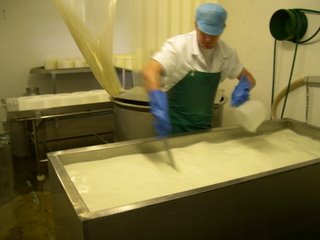
Saturday, September 16, 2006
Today is Jim's birthday! Happy birthday, sweetie!
I worked today. I want to get as much time in the dairy as possible. I shadowed Nick pretty closely. I took tons of photos because I wanted to capture the process in its entirety. I documented step by step Devon Blue and Harbourne Blue.
The day flew by. We had a nice tea time break, and we were back intothe swing of things. Jenny, the bookkeeper came today. She brought her dog, Daisy the black lab. Very sweet dog. Just didn't understand why she couldn't lean against our cheesemaking clothes.
Nick is lightning fast in the make room. He does everything with a sure and the bold confidence of someone who's been doing this for a while. Nine years. I hope to have that steady of a hand someday. I assist Liz with scraping and wrapping cheese for wholesale orders when I wasn't taking pictures.
We quit around 3:30. I decided to be naughty. I drove into Totnes and went to Grey's Dining Room and had a Devonshire Cream Tea. Ohhhhh. I had to have another scone before I left. My first scone was just as good as last time. The second scone was a bit overbaked. I slathered every bite with a thick layer of clotted cream and a layer of jam. Light and warm, it melted in my mouth. Washing it down with a sip of tea is perfect.
Clotted cream should have a nice bit of crust. The mark of perfection. My goodness this stuff is amazing. It just oozes with ropey threads when you spoon it onto a scone.
I asked the waiter for their secret. How do they make such amazing scones? He looked at me with a sideways glance and said "It's our secret. But I will say this. We use butter." Nick tells me to use cold fingers and don't overwork the dough. Make sure everything is cold. He also says his scones are crap. His wife, Sally makes the best scones. Teach me!
I go home and clean the bathroom. I start to pack. It makes me sad. Robin and Sarie are returning and I'm being forced out of the nest. I've grown fond of the silence. It is very peaceful. I also like the hive of activity all around me during the day. It keeps me going.
Posted by
Sairbair
at
2:51 PM
0
comments
![]()
Labels: Ticklemore Cheese Devon England
Pheasant pie, my dear and Dartmouth
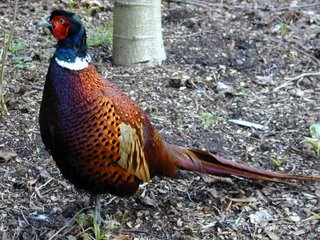
Friday, September 15th, 2006
Another beautiful morning. Got up and was eating breakfast when Nick strolled into the living room in his blue hat, white lab coat, dark green apron, and green wellies. He's got to check an order sitting by the fax machine. "Oh, good morning. I brought you a pheasant. Did you see it in the fridge?" I hadn't been looking for a pheasant when I grabbed the milk for my cereal. I missed it somehow. "I hope its dead by now. I'd hate to have to be the one to dispatch it and pluck it." I said. "Oh it's quite dead. It was in my freezer. You can have it. We need the room." He then goes on to give me an elaborate recipe for stuffed pheasant with pâté and wild mushrooms in a short crust pastry (it is a modified version of a recipe he made at The Carved Angel in Dartmouth.) I just look at him. "Do you see this fridge? Have you seen the lack of spices in that cabinet? I'll see what I can do." "Oh, well, it is quite easy, really. The short crust pastry is 50/50 fat to flour, etc…" I'm trying to eat everything I bought. I don't want to buy much more. I'll see how I feel at suppertime. I must admit, no one has ever given me a pheasant before. I was touched and thanked Nick profusely. He's watching out for me. Now if I could have him procure a nice lobster, that would really make my day.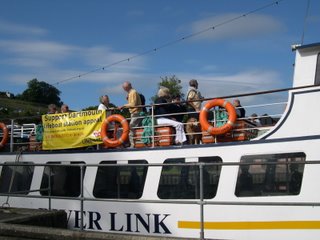
I feel the need to take advantage of the fine weather on my final Friday in England. Drove down to Steamer's Quay and caught the Riverlink boat on the River Dart. It is a pleasure boat, giving a guided ride from Totnes to Dartmouth or vice versa. Due to the fact the river is heavily silted up, boats can only sail during high tide. I had grabbed a schedule the other day, so I caught the 10:30 sailing to Dartmouth. It's a 45 minute ride on the river. We sailed alongside dense oak woodland and nature preserves. I saw Ticklemore up on the hill as we headed downriver. I got a good look at the Sharpham Estate and vineyard. There were lots of cormorants, egrets and herons perched along the bank, watching us sail by. When we were near Dittisham (pronounced Dish'm) the guide pointed out a fisherman working on his oyster beds. I look over and see this shock of wild, windswept blonde hair scattered about the head of this burly, unkempt man working on board a medium size fishing boat. I recognized him instantly. "I know that guy!" I told my seat mates. It was George Congdon, Robin's son. Small world.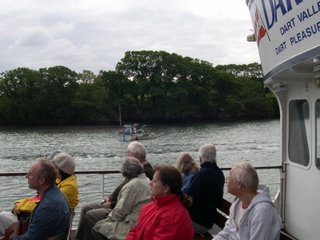
We drifted past Dittisham, a large village clinging to the side of a hill above the river. Farther down, on the other side of the river we passed Greenway, the house that Agatha Christy lived in. It is now owned by the National Trust and is in the process of being restored. It should be open to the public in a couple of years. It was a very pleasant boat ride. I also saw the estate of Sir Walter Raleigh. His descendants still live there! Huge wooded place along the river, just outside of Dartmouth. We arrived in Dartmouth and pulled up to a pontoon next to the Station Café. Dartmouth never had a rail line through it, but the Victorian Era developer had hoped to bring the Great Western Railway into town. The idea was shot down after he built the station.
I spent a sunny afternoon exploring the town more thoroughly. It is very hilly, so the higher up you walk, the better the view. Dartmouth has some amazing views. Friday is market day in Dartmouth, so I walked up to the market square and looked at tables full of tools, socks, and veggies. I continued wandering through town, going in and out of shops, looking for small, light and unique things to bring home. It was lunch time, so I also had my eyes open for a promising looking place for a meal. In one shop, the salesclerk suggested Alf Resco, near the lower ferry terminal. I find the ferry terminal and then spy the café. It looks like a great place for breakfast, but it doesn't offer much for lunch. I move on. I see an old stairway leading up the hill between some old buildings. Hanging over the stairwell is a promising looking pub sign for The Cherub. It's an old pub in a Tudor building. Lots of dark wood beams and white plaster. The walls are bowed, a sure sign this is an old place. It sounds like it's busy. Another good sign. I walk in. The bar is full of people, having a liquid lunch and waiting for food. The room holds 30 people and it is packed at the bar. There's seating upstairs if you're eating lunch, but drinks must be ordered at the bar. The bartender is a large fellow in his 50's, with salt and pepper hair and a full beard. He knows most of the clientele. I order a half pint of Addlestone cider. It's a cloudy one, drawn by a hand pump tap. Another good sign. I take a sip. Nice. A hint of sweetness, but not cloying so. Not too many bubbles, but still refreshing. I like this one. Good name. If I had a full pint, I would be addled.
The dining room upstairs is a dark room with carved wooden windows. None of the walls are square. The floor is tilting in several directions and the ceiling is low in several places. The tall waitress must duck every time she leaves or enters the kitchen. A good way to keep the staff sober, I think. The menu says this is one of the oldest buildings in Dartmouth. It dates from the 1300's. It was restored in the late 70's. Replaced many of the timbers with wood off of old ships. I had the seafood bouche, a mixture of fish like smoked haddock, cod, and shrimp cooked in a cream sauce and served in puff pastry. Quite tasty. I left very happy. When I told Nick about my experience he said it's a good pub. The bartender is "quite a good bloke."
I wandered back to the river embankment and had about half an hour to kill before my bus back to Totnes. For £3.00, I took a ride to the mouth of the river and looked at Dartmouth Castle and Kingswear Castle. Two fortifications protecting the river from invaders. The castles were rigged with a chain that they could draw up and keep invading ships from sailing up the river. Next time I might go and explore. There are some nice trails around the castle that lead to pretty coves and nice beaches.
Caught the 3:30m bus to Totnes. I could see over the hedges! It was great. I should have figured this out ages ago.
Pheasant Pie for supper, bird courtesy of Nick. I skinned the bird and cut the meat off of the legs and breast. I diced the meat and sautéed it in my little skillet. After the bird was browned, I cut up some bacon and cooked that off. I sautéed some onions, garlic, potatoes, and carrots in butter and olive oil in a Dutch oven. When the veggies were soft, I added my diced pheasant meat and bacon. Salt and pepper, of course. I added some red wine to the mixture. While this was cooking down, I boiling some diced potatoes in another pot. When they were soft, I mashed them with some milk and butter. I then added the mashed potatoes to the top of the pheasant and veggies, grated a bit of parmigiano reggiano over everything and into the oven at gas mark 4. (375F?) When the cheese melted and the juices were bubbling up, I pulled it out and ate it. It was heavenly! I like pheasant. I only got one small piece of buckshot in the bird. I found it before I bit into it. Yum. I have no qualms about eating in introduced species. They might be pretty, but they displace the local bird population. Eat and be merry.
In London on Monday, a performance I missed: Patty Smith and Kevin Shields (from My Bloody Valentine) performed together at the Royal Festival Hall. There is a Robert Mapplethorpe exhibit opening. Patty and Robert were lovers. I'd love to be there. I'm a big fan of Kevin Sheilds and to see him play with Patty Smith would be phenomenal. Hope someone archived it.
http://enjoyment.independent.co.uk/music/news/article1522987.ece
Posted by
Sairbair
at
2:42 PM
0
comments
![]()
Labels: Ticklemore Cheese Devon England
Thursday, September 14, 2006
Gobsmacked and Knackered
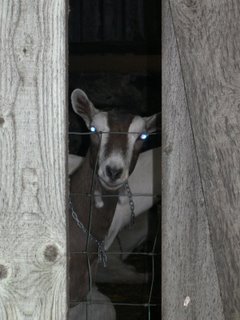
Favorite phrases in fashion right now: When you are rendered speechless and completely shocked you are gobsmacked. When you are exhausted you are knackered (sp?)
Thursday, September 14, 2006
Nick brought in a beautiful cookbook by his friend Jean Christophe Novelli called "Your Place or Mine." Beautiful photos and some nice looking recipes. I can't read for long because it makes me hungry.
I accompanied Ben to Button Farm to fetch the goat milk this morning. I felt like going for a drive and seeing the girls who provide the milk for our cheese. Ben and I zipped along the A385 towards Buckfast and Buckfastleigh. We pull into the farmyard and I see Susie herding a bunch of does into the milking parlor. Will shows up and starts pumping the milk into our milk tanks. Ben and Will talk about contractors and building techniques. I wander over and stare at some of the does. Goats are very curious animals. They stare at you and you can see them thinking. I'm sure they're wondering if I have food for them. No food, but I do have a camera. My flash spooks them and a few of them jump away from me. Will says if I want to play with the does and kids, let 'em know in advance and I can spend some time on the farm. That might be fun. I like goats. I love goat cheese. I just don't to care to keep any of them. I have enough problems with dogs and cats. We drive back to Ticklemore and I hop out of the truck while Ben deals with unloading the milk.
It's 11:15 and I need to drive into town. Shopping on Fore street was a painful experience as usual. New Mojo magazine should be out this week. I love English newsstands. The British publish a magazine for every age group and every interest. There are hundreds of magazines at every newsagent, and there are several newsagents on Fore Street. No Mojo yet, but they did have the latest Pokemon World. My niece will be happy. The gardening magazine section takes up an entire wall, I swear. Cooking magazines offer more temptations. I resist. But the free totebag giveaway that comes with this month's copy of Devon Today is hard to turn down. I manage to escape, somehow.
I had a disappointing lunch at a place (Wood's) in the Narrows. I had to wait 30 minutes for a bowl of veggie soup with a cheese scone. Good thing tipping is optional here. When I go to cafes or pubs in the area, I am always amazed at the large number of waitresses and waiters that always seem to be just standing around doing nothing. They just stand around and gab. They don't have to even take orders. When you walk in, you grab a table and look at the menu. Once you've decided, you go up to the counter and order. You pay for your meal at that time. Then you wait. The food comes from a mysterious kitchen that's hidden away. You never smell, see, or hear the kitchen staff. Often the kitchen is on another floor and your food is delivered via dumb waiter. When your food is ready, the bored waitresses debate over who will actually take your rapidly cooling meal to your table. Why this should involve five people behind the counter is anyone's guess. Like I said, they don't expect a tip, so I happily don't leave one.
I returned to Ticklemore so they guys could talk the van to Sharpham and pick up cheese. I spend the afternoon cleaning and getting rid of pamphlets that I've picked up during my stay. Robin and Sarie will be here on Sunday.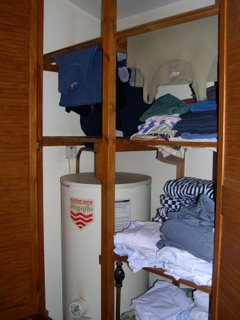 This is the airing cabinet. The heat from the water heater helps dry clothes. I prefer drying on the clothesline outside, but this works amazingly well. It is only problematic when I have sheets and towels to dry. It has space limitations.
This is the airing cabinet. The heat from the water heater helps dry clothes. I prefer drying on the clothesline outside, but this works amazingly well. It is only problematic when I have sheets and towels to dry. It has space limitations.
Snacked on an odd flavor of Burt's Chips, a Devon potato chip manufacturer. Firecracker Lobster flavor. I don’t pick up on the lobster, but they use a nice spicy paprika. An hour later my palms and feet start to itch. Dammit. I must be allergic to one of the seasonings. Powdered lobster, perhaps? Fortunately I have some Benedryl, so I took one. Forty-five minutes later, I'm feeling pretty sluggish, but I don't itch. Can't drive now. Guess I'm eating leftover chicken for dinner. Gotta clean out the fridge before Sarie and Robin arrive. They won't eat anything except my peanut butter.
My trip is winding down and I'm feeling the end rapidly approaching. It's like the last few days of summer camp. I've made new friends that I probably won't see for a long time if ever again, and I don't want it to end. In the world of my dreams, I'd convince Jim that we should move here and I'd continue working at Ticklemore. I like it here. I know that I must return home and follow my dreams in the land of my birth. Perhaps not in the Bay Area, but somewhere there's a place eager for me to set up shop and make my own cheese. Now I just have to find it.
Nick and Ben ask me the same question every week: "Do you know what kind of cheese you want to make?" With their help I'm getting a pretty good idea now. Got goat and sheep milk? I've got some nice ideas for a few tasty sheep and goats milk cheeses ready in four weeks and four months. Want some?
Posted by
Sairbair
at
4:23 PM
2
comments
![]()
Labels: Ticklemore Cheese Devon England
cheese and the Beeb
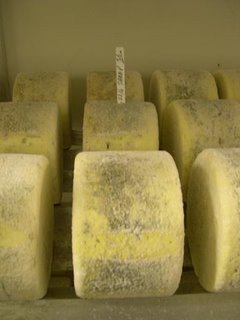
Wednesday
September 14th, 2006.
Liz and I work together today. The guys have the day off. The first part of the day involves the usual morning routine. One of us dry salts Monday's cheese and moves them into the Salting Room. The other gets to spike 6 day old cheese. I volunteered to spike! I count the number of cheeses to spike and prepare the shelves for the cave. Each shelf is composed of two aluminum bars and must be sprayed with Quadec (sp?) a long lasting sanitizer, then the shelves are wrapped with cling film and placed in the cave (aging fridge.) Each shelf holds seven blue cheeses, and they are stored three deep, so each shelf will hold a total of 21 cheeses. I wrap twelve aluminum bars and place them in the cave. I grab the trolley of goat cheese dated the 7th of September and begin spiking them. Each cheese takes about 10 seconds to spike. I then stack them on another trolley and wheel them into the cave when I have about 12 of them spiked.
Entering the cave is always exciting for me. I open the door to the walk in fridge and see a long, narrow room lined with cheese along both walls. When you first enter, you find the young Ticklemore Goats maturing. The new ones look naked sittin on their white plastic bakery trays. They have no mold. On other trays I see cheese that growing a light dusting of white p. candidum mold. I see others that are almost ready for sale. They are enrobed in a healthy layer of white mold, mixed with a dusting of blue/grey mold from the ambient blue cheese mold in the cave. The blue is only on the outside and doesn't hurt the cheese.
In an ideal situation, they would have two separate aging caves; one for the blue cheese, and another for everything else. No space, unfortunately. Above the Ticklemore Goats, wire racks of Goat cheese buttons are aging for about 10 days. They also will grow a light coat of white mold. These are made and sold exclusively at Ticklemore Cheese Shop. Moving farther into the cave, the walls are lined with cylinders of cheese. They resemble small tom-tom drums sitting on their sides. Some have grown a nice dusting of blue mold and are ready for scraping. Others are just showing signs of change, with patches of mold forming on the surface.
Towards the back wall are a few more racks of white bakery trays. These are filled with the rarest of Ticklemore's cheeses: Boyton and Ticorino. Both are aged ewe's milk cheese. Boyton, as I mentioned before reminds me of Basque sheep cheese like Abbaye de Belloc with tiny eyes and a smooth texture, and nutty, slightly toasty flavor. I haven't tried the Ticorino, Robin's version of an Italian pecorino. Not sure what he based it on. It has a natural rind, sort of dove brown in color. Nick and Ben keep telling me what a pain it is to make. They put a lot of effort into it, and don't have a lot of cheese to show for it in the end. They only sell Boyton and Ticorino at Ticklemore Cheese Shop and Country Cheeses in Tavistock. If you're ever in Devon, I suggest spending an afternoon in Totnes and pay the cheeseshop a visit.
HOW I SPEND MY EVENINGS.
I am here by myself. I don't go out often because I am alone and the dollar is weak and doesn't buy much. I've been listening to the radio a lot. I flip between BBC Devon and BBC2. The local BBC stations really emphasize community. The DJ's encourage calls, text messages and emails. They announce birthdays, anniversaries, lost dogs, and other things relevant to the community. Often the DJ say something like, "Well, I just heard from Mrs. Beasley from Newton Abbot, who says she's in the garden and her dog, Avery, just loves it when we play Rod Stewart. Well, Mrs. Beasley and Avery, this one's for you." Cue Rod Stewart singing "Mac the Knife." The music they play is all over the map. I often hear the current #3 single from the Scissor Sisters, followed by Frank Sinatra, then The Beatles, into Elton John. BBC2 is even more eclectic. They'll play the Arctic Monkeys, The Feeling, The Beach Boys, The Kinks, and REM. Then there will be an hour long country music show that features Waylon Jennings, Amy Grant, and Confederate Railroad. Next up will be a funk show on Thursday nights. A lot of the DJ's are only on once a week, and then only for an hour or 90 minutes. You can't play that many songs in an hour. Strange formats.
TV: No cable or satellite. I have four channels to amuse me. BBC 1 and BBC 2. Fine if I want to see shows about the great gardens of Britain. ITV 1 and Channel 4. Quiz Shows rule the airwaves. I'd be really happy if I liked Sharon Osbourne. It looks like Ozzy's wife has moved the family back to England an is taking over ITV. She's got her own chat show where she takes her gothic inspired stage and tries to be matchmaker and gift giver. She also has a dog or two wandering around the set. Then if you haven't had enough, she on the U.K.'s version of American Idol, The X Factor. She's the nice one, sitting next to Simon Cowell. Click! TV sucks.
Since I am not distracted by the garbage being broadcast on English TV, I have been spending my evenings collecting my thoughts and writing. Being alone with my thoughts can be dangerous. Watch out, I'm armed with a computer!
Now Playing: Richard Thompson "1952 Vincent Black Lightening"
Posted by
Sairbair
at
4:09 PM
0
comments
![]()
Labels: Ticklemore Cheese Devon England
Have a cuppa tea

Tuesday,
September 12, 2006
The morning flies by quickly. Lots of cheese to salt. I asked Nick if I could help with the afternoon goat cheese today. "Of course," came is response. It's nice to be well received.
Shortly after 10:00AM, Nick utters the phrase "Well, alright. Let's go put the kettle on." We don't just take a break, we pause and refresh ourselves with a fine cuppa PG Tips for Ben and me. Green tea for Nick. I'll have to keep up this tradition when pacing my own work day.
After tea, Nick pulls out several batches of Devon Blue to prepare for wholesale orders. The mature cheese must be unwrapped from its plastic wrap skin, scraped with a knife and then wrapped in a thick gold foil. Then we put a sticker on it and put them into the fridge. When preparing orders, the foil wrapped cheese is placed into cardboard boxes and sent by refrigerator van to all points around the UK. Couriers pull up several times a day. They always wear shorts and are a nice bunch of guys. Around noon, Nick begins to make Harbourne Blue. He adds the starter culture as he's filling the smaller of the two rectangular vats with fresh goat's milk. When the vat is full, he adds a capful of liquid blue mold to the milk. He leaves it to ripen. When it's time to add the rennet, I walk over to watch. He measures out a small amount of rennet and adds it to a pitcher of water. He gently stirs the milk and quickly pours the rennet into the cultured milk. Gives it a quick stir and covers the vat to let it the rennet turn the milk into a soft jelly. We go back to scraping and wrapping mature cheese.
Nick keeps an eye on the clock. Time for first cut. He hands me the cheese harp. Oh boy! I cut the curds as instructed. I'm less timid this time, more sure of the motions I must use to ensure an even cut. I go back and forth, cutting the gelatinous white mass into small cubes. The whey begins to be released immediately. Once the curds are cut, the knife is set in one corner of the vat, the cover is replaced, and we wait. Time for second cut. I use more of a stirring motion with this cut, making the curds even smaller and releasing even more whey. They shrink a lot by the time they reach the moulds.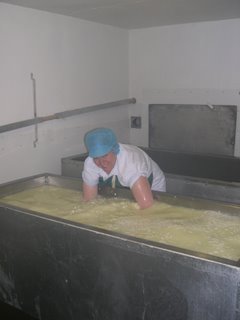 Camera lens got fogged up in the humid making room. Sorry mom.
Camera lens got fogged up in the humid making room. Sorry mom.
Time to stir the curds. I roll up my sleeves, scrub up, and plunge my arms into the vat. The goat curds feel very different from cow's milk. The body is much more delicate. It feels lighter. The curds are smaller. It doesn't have the same smell, less sweet. I stir all around the vat, twice. Cover and wait. Time to stir again. I let the curd settle for a moment. We then push the curds to one end of the vat, install a semi-circular, perforated device that keeps the curd in the vat, but lets the whey out. We drain the whey and scoop the curds out of the vat and make cheese. Moulds get filled to within an inch of the top. After several moulds are filled, Nick flips one on top of another, so the contents of two moulds combine into one and drain together. After 20 minutes, they have drained and shrunken a great deal. The top mould is pulled off and the cheese in the bottom mould looks like a huge cupcake, with a large lip on top. We made about 16 Harbourne Blues today.
Posted by
Sairbair
at
3:37 PM
0
comments
![]()
Labels: Ticklemore Cheese Devon England
My final week begins

Third week Ticklemore.
My last week.
Monday, September 11, 2006
Busy today, seems to be normal for a Monday. Lots of cheese to salt and spike. I enjoy working with Ben and Nick. We are getting a good work rhythm together. Ben is upbeat and pretty quiet, and Nick is cynical and entertaining. They both know their tasks and perform them without even thinking. I admire Nick's ability to teach. He clearly communicates what is needed and what to expect. He understands that I am here to learn, and calls me over to make sure I'm in the right place at the right time to observe or participate in the cheesemaking process. He's got a good hands on approach to the learning process.
Nick's been cheesemaking for over nine years. Ben thinks he's a better cheesemaker than Robin, now. He's an accomplished chef, having worked with two notable chefs, Keith Floyd and Jean Christophe Novelli. Nick, in addition to being a cheesemaker, also dreams of having a bed and breakfast. His wife Sally is a former pastry chef. I think they'd do very well if he decides to follow his dream. Since he's a natural teacher, I suggested that he might do something like a posh, destination B & B and cooking school. Something similar to the Philo Apple Farm in Mendocino County. Devon has lots of farms and local food products. Nick is well connected in the area, so it would be an easy transition. He's a gifted cook, having sampled some of his dishes. I'm good at supporting the dreams of others, it's hard for me to see all of my own possibilities. I'm still working on that.
After work I went to the Dartington Cider Press to look for gifts. It is a complex of shops, each one with a different focus. Bookstore, kitchen wares, restaurants, garden center, toy store, local art glass, ceramics, and woodturning were all featured. The buildings are located on a corner of the Dartington Estate. I didn't buy much, but it's a good place to browse. Ben says it's a great place to shop for Christmas presents. I wish the dollar was stronger. I was tempted by lots of fancy teapots, mugs, local ciders, and tea towels. One Pound Sterling is currently trading for $1.89. I really feel the impact of the weak dollar right now. Things appear to be priced the same as back home but when I work out the exchange rate, it costs twice the price than in the states. For instance, a £35.00 teapot is $67.00!!! It keeps my shopping to a minimum. A modest sBLT, my sandwich of choice cost £4.15, US translation: $8.00!! Ugh.
I look at shopping as a challenge. I must find things that I can afford and can carry easily. Things I like to bring home: local jams, English plum preserves like Damson or Green Gage are two of my favorites. Hard to find CD's by English artists, books, magazines, tea, Crunchie candy bars, tea cozies, cheese knives, a cheese cage, and of course, cheese.
Posted by
Sairbair
at
3:14 PM
0
comments
![]()
Labels: Ticklemore Cheese Devon England
Tuesday, September 12, 2006
Microbe Management
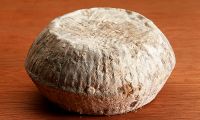
Sunday, September 10, 2006
Started the Sunday procedure around 9:00AM today. Many things to take care of. I break a sweat this morning, There is lots of scrubbing, turning, scrubbing, salting, scrubbing, stacking, scrubbing, soaking, scrubbing, rinsing, scrubbing, sweeping, scrubbing, spraying, and wiping.
Three hours later, I turn off the lights and lock up. The day is bright and sunny. I'm going to explore along the River Dart today.
Making cheese is like making music. A musician or composer writes a song to share an idea. A cheesemaker makes a cheese to share a way of life. Both offer ways of connecting, of sharing oneself. A song has a more immediate rate of return. Cheese reveals its potential more slowly. It takes weeks or months to mature and reveal it's potential, it's flavor.
What happens in between the time a cheese is made and when it is eaten? It matures. The bacteria and molds and the proteins do a dance with enzymes. They change and grow. They break down. A cheese is ripe when it reaches the point that we find most pleasing. It is an imprecise science. That's why cheesemakers are artists. Robin Congdon once said in a interview that cheesemaking was like farming microbes. You are coaxing, guiding, and encouraging the beneficial bacteria, enzymes and molds to achieve an outcome that is something close to what you hoped for. This skill comes with experience. This experience is what drew me to Ticklemore. I am so happy that Nick and Ben and Liz are so open and eager to share their knowledge with me. I wish I could bring them all with me when I start making my own cheese. It helps to have someone around who knows the drill.
Posted by
Sairbair
at
1:32 PM
0
comments
![]()
Labels: Ticklemore Cheese Devon England
A motte and a bailey

Saturday, August, 9th.
Autumn is in the air. Leaves are just starting to turn and drift to the ground. I keep seeing windfall apples on the sidewalk. The light is changing. Nuts are ripe. You can smell it. It is getting colder at night. Game season is almost here. I have 10 more days in England.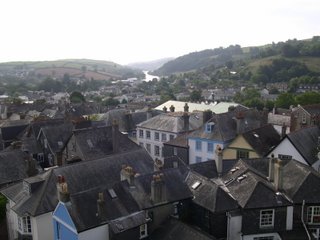
I stormed the castle this morning. I shot lots of pictures of it. It is Heritage Weekend, so admission to Totnes Castle, the Costume Museum, the Guildhall, and the Totnes Museum were all free. Yay! I went to all of them. The castle had panoramic view up the River Dart all the way to Dartmoor. It's clear why it was built in that location. The Guildhall was sort of dull. It is still in uses and is quite old, but I don't need to see the mayor's cape. The costume museum had an exhibition on travel clothes from the 17th century to the 1970's. It also has an Elizabethan plaster ceiling. Very ornate ceiling that's been well preserved. The Totnes Museum was well laid out with displays of old apothecary items, an Elizabethan kitchen, a sitting room from a 17th Century merchant, and other local historical paraphernalia. There' an old loom, lots of bottles, coins, water jugs, and furniture. It was displayed well. There's a nice garden in the back, too.
I shopped a bit. Only 10 more days! I must start looking for presents!
Posted by
Sairbair
at
1:13 PM
0
comments
![]()
Labels: Ticklemore Cheese Devon England
Monday, September 11, 2006
Start Bay and Hope Cove
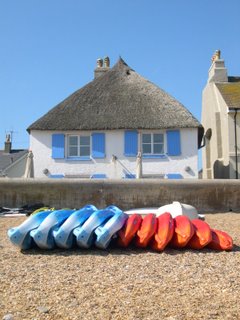
Friday, September 8th.
Bright and beautiful today. The weather forecast is for a fresh, easterly wind. Fresh means a stiff breeze I think. Every time BBC Devon describes it as a fresh wind, the leaves seem to be stripped off of the trees. It is really blowing today. Should make the flooding even more exciting. I'm going to the beach to see what I can see. I spend a leisurely morning studying the Ordinance Survey map, plotting my assault on the roads of southeast Devon. Ben comes in and has his tea break early. He must go and pick up the goat milk for the afternoon cheese. He goes off in the Tata. Nick and Liz join me in a few minutes. The phone keeps ringing. We can't speak a sentence without being interrupted. Call after call comes in. The phone rings again. In unison, Liz and Nick shout "Oh fuck off!" Nick then picks up the receiver and answers politely, "Ticklemore cheese…."
I'm going to Start Bay. The road goes right along the beach and the wind should make for some dramatic waves. But I'm torn. The area around Salacombe looks tempting, too. I decide to go to Start Bay and see what happens from there. I plot my course and off I go. The first part of the drive is easy. I'm on the A381, driving through Harbourton and Halwell. I turn off before I get to Dartmouth and head for a town called Strete. The lane is barely wider than my van. It is fairly straight, so oncoming traffic is easily avoided by using the occasional turnout and yielding. It is like a game. I go then he goes. If they have a turn out, they pull over and flash their lights, letting me know it is safe to proceed. If I have a good spot to pull over, I flash my lights and let them go. It is all very polite and orderly. Somehow it works.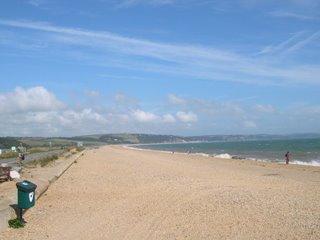
I take the wrong tiny lane on the map. It goes through Blackawling, instead of next to Blackawling. I stop and redirect myself with my handy map. No problem. There is another tiny lane that will take me to the road to Strete. I find it and drive until I come upon a construction crew. The road is closed and they are digging it up. Somehow I missed the tiny sign back in town. I shoot the crew an evil look and turn around. Back into Blackawling, this time following signs that redirects me down yet another tiny lane. I get stuck behind a large tractor. It is so large, that he can barely squeeze down the lane. The large tractor tires chew the shrubs on either side of the lane. We plod along and eventually hit the road that is a straight shot to Strete. I can tell I'm getting closer to the sea. The land is more level. I hit Strete and decide to keep on going. I turn right onto the A379 and drive south towards Slapton and Torcross. As I leave Street, the road begins to descend towards the beach. The road curves and there before me is a stunning view of Slapton Ley, Torcross and a lighthouse off in the distance. Back home, if there was a view like this to be found, there would be a place to pull over and admire the view. The English value their land too much. No place to stop. I'll just have to drive down and see it up close. I drive down to Stretegate at the north end of Slapton Ley. Slapton Ley is a spit of land/sand that separates the English Channel from a fresh water lagoon. It is a couple of miles long and has a road built on top of it. The lagoon is a nature reserve, filled with lots of waterfowl. I drive down to the far end of the ley and stop at Torcross.
This is also the beach where American soldiers practiced for the D-Day assault. The locals were evacuated so that the military could take over and prepare for the crossing of the English Channel. Many soldiers died on this beach before they even went to Normandy. The Germans managed to get through the blockade and sink a boat. Forty years later, a Sherman tank was recovered from the boat that sank and now sits next to the lagoon at Torcross. The tank is the focal point of a poignant memorial to the American soldiers who died here. There was an old war veteran looking at the memorial with his wife. They were discussing Winston Churchill and what a great leader he was. "He was a wonderful man," the old gentleman said. There were lots of flowers set around various plaques. Moving tributes to lost loved ones who are still missed. I must admit, I was choked up a bit as I reflected on the great loss of life and the sacrifices that were made to end the war and the atrocities committed during that war. When I stand upon the soil that witnessed these events, it makes it more real for me. I cried at Dachau. I had nightmares for years after I visited Hiroshima.
Today Torcross is a clean little beachfront village that faces Start Bay. It is a pebble beach. The wind is whipping across the Channel and straight onto the beach. It's 12:30, time for lunch. I have a few options at Torcross, so I wander into the Start Bay Inn, a pub that features fresh, local seafood. I walk in and grab a seat. Everyone around me is ordering one thing: fish and chips. I close the menu. That was easy. I have my choice of cod, haddock or plaice. Haddock for me, thanks. I am the youngest patron in the Pub. Everyone is at least 70. Ben told me that after school starts, the tourism in the area switches from families to seniors. Well I found them. They're all having lunch at the Start Bay Inn. As I waited for my meal, the place filled up. My food arrived. Two good size pieces of meaty white fish, not too greasy, and a generous pile of chips. It was piping hot.l I have no idea how the rest of the menu is, they had monkfish, skatewing, and whole bass on the specials board. No one was ordering it.
I finished my meal and walked outside. I sat on a rock on the beach for a few minutes. I hopped across the road and walked around part of the estuary. The fresh water lagoon has a healthy reed bed and lots of birds. People were feeding the ducks and swans. The trail wasn't well developed and it was still windy, so I walked back to the van and drove half an hour over to Hope Cove.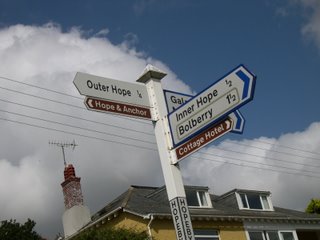
There are two tiny villages that I were my destination. Inner Hope and Outer Hope. A skinny lane leads off of the A381 to these miniscule towns. I almost lost hope, as I took a wrong turn due to the lack of signage once I got off of the main road. I eventually found Hope Cove but got quite angry over the astronomical parking fee they charge. Three quid just to park my car, no matter how long you're there. Sod off! I parked anyway and walked over to take pictures of the pretty rock formations. There was a nice rock shelf full of tidepools. I didn't linger because I wanted to head for home. I was tired of driving along these skinny roads.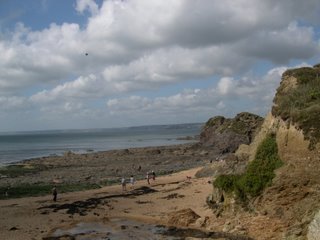
I got home at 4:30. Enough time to clean up and go into the Dairy to say hello to the newly made cheese. Gave 'em all a flip and headed back into the kitchen to make supper. On tonight's menu: fresh fish that Nick got from his "fish guy." Pollack and guernot. Nick gave me a recipe for Thai fishcakes. Pretty easy, once I filleted the fish. I sort of hacked up the fish. I can filet trout and cod pretty well. Fish that have a round shape like Pollack pose a problem for me. Since the pieces were going into the food processor, I didn't care that they weren't pretty. In the end, I was very pleased with the results. Pollack makes great fishcakes.
Posted by
Sairbair
at
11:40 PM
1 comments
![]()
Labels: Ticklemore Cheese Devon England
Sunday, September 10, 2006
Give me the perfect scone

I asked the tourguide where she would take guests for a Devonshire Cream Tea. She recommended two places, Greys Dining Room and Anne of Cleves. I've been trying to avoid this high calorie indulgence. I finally caved in and decided to go to Greys. Greys is at the top of Totnes, just after the Narrows, near a pub called The Bull. The walls are covered with teapots, old plates and tea cups. They have a tea list that puts many wines lists to shame. It is extensive. They serve light meals, a wide array of mouth watering cakes and pies, and of course, cream teas. I opt for the classic cream tea. The waiter brought out a small silver pot filled with water, just off of boiling, a tea strainer, another silver pot filled with hot water, and a caddy filled with strawberry and blackberry preserves, a huge dollop of clotted cream and two scones. I was in heaven. I picked up a scone. It was still warm. A very good sign. I split it open. It was very light, flaky and tender. I smothered half of the scone with a layer of clotted cream. I broke off a bite size morsel. I added a spoonful of blackberry preserves to this bite. I gingerly put it into my mouth. Ohhhhhhh. Yum. The scone was perfect. Imagine the perfect buttermilk biscuit and make it slightly sweet. This scone was indeed tender, flaky, it broke part with lots of crumbs, you can tell the dough wasn't handled too much. It was light, not a hockey puck. The scones you get at Starbuck's or Pete's are not what I'm talking about. I don't know what those are, but they're not scones. This is what a scone should be. And covered with clotted cream and fruit preserves just makes it better. I was doing a happy dance in my chair. I can go home now. I've had the perfect scone.
Mom and I compare all scones to the scones make by the ladies that ran the tea room at St. Giles church in Edinburgh, Scotland. As she will tell you, "Under the Aisle" made scones that spoil you. It has taken me over 20 years to find their match. Today I've found some competition for "Under the Aisle." I don't have to go to Scotland, either. I want to thank Greys Tea Room. I have found a mouthful of nirvana. Their custom blended house tea was pretty damn good, too. If you're ever in Totnes, eat a scone.
Posted by
Sairbair
at
4:22 PM
0
comments
![]()
Labels: Ticklemore Cheese Devon England
Storming the castle and everything else OR HAPPY BIRTHDAY TOTNES

Thursday, Sept. 7th, 2006
This week marks the 800th anniversary of Totnes. To celebrate the occasion, the town is hosting the Totnes Festival from the 6th to the 16th of September. There are events to take in from musical performances, plays, storytelling, movies, and walks.
I joined the free Heritage Walk of Totnes. It left from the Tourist Information office by the river. For two hours we walked from the river to the top of town, looking at buildings and areas of significant events around town. When the Saxons arrived at Totnes they erected a large tower where the castle stands today. Totnes was and still is the highest navigable point on the River Dart. The river provided easy access for merchants to move there goods. The area along the river is lined with old warehouses and mills. The TI is built in an old mill. Paper and cloth was made in the mills. The warehouses also housed another key export, cider. We walked up Fore Street, the narrow and busy main street. The area closest to the river is the most "modern" since it was redeveloped time and time again from the 18th Century to the 20th Century. There are Georgian buildings next to drab modern ones. As we climb up the street, the buildings get older.
Totnes flourished in Tudor times. The Elizabethan merchants of the area did well and Totnes thrived. Since then, business moved elsewhere, and the town was left relatively untouched. This is why it has so many surviving Tudor style buildings. Another factor that preserved the buildings is the slate tile that covers them. Slate adds a protective skin and protects the old timbers beneath them. Fire can still do serious damage, and since the buildings are built adjoining one another, much like San Francisco, fire spreads easily and can take out many buildings. There is a long history of fire in Totnes. Even the historic East Gate, the arched gate that crosses over Fore Street is not the original. This was restored after a fire in the 1950's.
There are lots of other old buildings. The Guildhall is dates from the 15th Century. It had been a priory that survived Henry VIII's dissolution of the church. Most church buildings were destroyed, but this one managed to dodge the wrecking ball and was given to the town to use. It is still in use today by the town council and other civic groups. Concerts are also held there, as they are this week for the festival. The Guildhall is situated behind the Church of St. Mary. This red sandstone church dates from the 1400's. Inside is a beautiful barrel ceiling. The most unusual feature is the rood screen in front of the alter. It is carved from stone, not wood. The elaborate tracery and delicate fan work and fading paint reveal a level of devotion and skill that is lost today. It was carved as if it was wood. Wonderful detail work.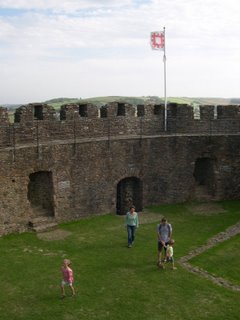
We continued our tour at Totnes Castle. The castle was originally built of wood by the Saxons to overawe the locals and stake their claim on the land and set up protection from the Viking raiders. Then the Normans moved in and added the stone motte and bailey. This tower housed soldier and the local government, originally. People lived just below the manmade hill inside the stone walls that surrounded the hill and tower. The tower itself was used as an area of last retreat and as a vantage point. We didn't actually enter the castle. No free admission today. We all stood at the castle gate and looked up at the keep from the outside.
We walked back up to the main street which takes a left turn into what's called The Narrows, a part of the road where the buildings take over and the street is almost an afterthought. Pedestrians are left to fend for themselves for the sidewalk is a mere six inch slab of granite, more to act as a safety buffer for the shops if a car should stray too close, not provide a safe place to walk. We walked up to another narrow street that intersects The Narrows called South Street. It is the site of an old bakery. It has shutters that open up to allow passersby to purchase bread through a side window. That was not the only significant thing here. Our guide pointed out the large spigot below the window. This spigot is part of the public water system that has been in place since the 1500's. Clean drinking water has been available to the citizens of Totnes for centuries. The water was carried from springs to taps all over town via elm water conduits. The pipes lasted for centuries. They were finally replaced in the late 1800's when people began to complain about the sediment in the water. The wood was finally rotting. There are several surviving sections of wooden pipes at the Guildhall and the Totnes Museum.
We continue up beyond The Narrows to Leechwell Street. We went beyond the Kingsbridge Inn (my favorite pub) and went to another favorite spot of mine, the Leech Wells. Our guide recently learned that the three springs that flow through the Leech Wells still offer healing relief to those who seek it. When she was preparing the tour, she mentioned to a colleague that she was going to the Leech Wells. His five your old daughter pipes up, "Oh the place with the magic waters. I love that place." It seems that the little girl has terrible eczema. Her father, being a local historian, knew about the healing properties attributed to the waters, so he thought he'd see if the water still worked. Each of the three springs has a name that corresponds to its healing properties. The spring on the left is called Snake, and it is supposed to cure snakebites. The center spring is called Toad and it helps with skin diseases. The right hand spring is called Long Cripplers and it is used for eye diseases. Many of the holy wells seem to help heal eye problems. The little girl has found immense relief from the water of Toad spring. I guess there is no reason the water should not help, even if the site is not in pristine condition. A leper hospital was built nearby to take advantage of the spring.
Our walk concluded at the Kingsbridge Inn. This pub is the oldest in Totnes. It is at least 600 years old. I had thought it was older than that, but there are accounts of it going back several centuries. Inside is an old pump that draws water from the Leech Wells. Due to health regulations, they are not allowed to use it, but it still works should anyone try. Like any old pub in England, this one has a ghost. Her name is Mary Brown and she was a barmaid. She was killed by a drunken patron and will only appear to women. Totnes has a lot of ghosts around. Old buildings must soak up all kinds of memories and energies. Or people just like Totnes so much they don't want to leave. The Guildhall supposedly has a few ghosts, too.
I eat a quick lunch at Café India, the Indian restaurant at the top of the town. It was surprisingly good. My favorite dish, Saag Aloo, potatoes in spinach was made with fresh spinach and delicately seasoned. Usually the dish is very saucy and heavy. This was not. It was sautéed. I enjoyed everything on my plate. I drove back to Ticklemore and caught Nick, Liz and Ben at the end of their lunch break. Nick grabbed the keys to the van and raced off down the driveway. He returned a few minutes later with a friend from New Zealand. Andy is a set builder/carpenter and is on a six week vacation. He used to work with Nick at a restaurant in Dartmouth. As he put it, in order to take a vacation, he must leave the country. So he's here and he eager to drink. He likes English beer and he likes to hang out in pubs. He's pretty self sufficient, I suppose. I guess everyone has their own way of relaxing. Everyone around here seems to know that I don't drink much. I seem to keep sticking my foot in my mouth when I start condemning excessive drinking. I am not used to it and they are. It must be a cultural thing. Part of the pub culture that I glimpse occasionally. I'm learning to bite my tongue when these guys talk about sitting around and drinking all day. That is not my definition of fun. I'd rather go to the movies, go hiking, throw a Frisbee, or read a book. I'm not in California, am I?
Ben and I go to Sharpham to pick up the cheese for the shop. We load up the back of the van with Sharpham Bries, Rustic, and Ticklemore Goats. Ben and I talk about what's involved in the building of a cheese making facility. Boring stuff like good drainage, wall coverings, size, etc. As we're driving I see a tractor harvesting corn to be used for silage. "You don't call it maise?" Ben asks. "No, it's corn," I reply. "What do you call corn?" I asked. "Wheat or barley," he said. "OK. So what do you call the corn that you eat?" "Sweet corn," Ben says. He's about to say something else, but he's getting caught into the same trap that I'm caught in. When is corn, corn? When is it maise? Is sweet corn also maise? I'm still not clear, but at the grocery store I see it called sweet corn. We arrive at the Dairy and unload the cheese.
I enter the dairy around 6pm to tend to the new cheeses. There's the usual batch of Devon Blue from the morning. They made a large batch of Harbourne Blue in the afternoon. No Ticklemore Goat. I see some experimentation going on.
The moon is full tonight. It is huge. It is bright. It is stirring the animals in the fields around me and I hear them yipping and calling. It is also making the high tides even higher. Localized flooding on the tidal rivers and creeks. The moon is so bright it is hard to sleep.
Posted by
Sairbair
at
3:55 PM
0
comments
![]()
Labels: Ticklemore Cheese Devon England
Learning, Good and not so good.
Wednesday
Made a rookie mistake. Normally, after the blue cheese gets its second dry salt rub, they are put back into their plastic trays without their moulds. Moulds are washed up and put into the descaling barrels. Well, I went about salting the cheese that needed salting for the first time and the second time. I put them all back into their moulds. Only when Ben asked where the moulds were that needed washing, did I realize my mistake. Oops! I went into the area where the salted cheese is stored and carefully extracted each cheese from its mould. I will proceed with caution next time.
Ben was working with us today. He normally has Wednesday's off, but since he took Tuesday off, he came in today. Since he was here, we made goat cheese: Ticklemore Goat and Harbourne Blue. We also filled a bunch of wholesale orders. My right wrist was sore from the repeated scraping of blue mold off of aging blue cheese on Tuesday. Thank God for Advil. I wrapped lots of cheese today and let Liz scrape. She's been doing this stuff much longer than I have. I am humbled by their stamina.
After tucking the young cheese in for the night, I returned to the kitchen. I spent a quiet evening at home making a baked pasta dish with ground turkey, tomatoes, tomato sauce, comté and Ticklemore's boyton, the aged sheep's milk cheese. Everything blended nicely and the cheese melted well. I wasn't sure what would happen to the boyton, but it worked well. Lots of leftovers. Too bad there's no microwave.
Boyton. Can' t find this treasure back home. Yummy cheese from ewe's milk.
Posted by
Sairbair
at
3:40 PM
1 comments
![]()
Labels: Ticklemore Cheese Devon England
Wednesday, September 06, 2006
Ask the cheesy cheesemonger
How do you remove that sticky curd from all over everything? Start with cold water. It knocks off curd and greasy milk residue. Then scrub in hot sudsy bubbles. Leave to air dry. That's the sanitary way to clean cheesy stuff.
Ask the Cheesemonger
This is a question that I am often asked:
-From a friend's email:
I was thinking about something as I was pulling a hunk of raw milk cheese out of the fridge. It was starting to develop mold in the crevices and tiny holes but I ate it anyway, thinking that "heck, blue cheese is moldy cheese". And then I wondered if I should have done that? When is mold acceptable? When is it, well, mold? And therefore unacceptable? And I almost always eat the rind, seemingly with no consequences. Are there times I shouldn't be? (Other than when it comes to the manchego with the superclingy wax.)
Cheesemonger Sarah says:
Mold isn't inherently bad, but it's rather unappetizing in the wrong place. I usually cut it out. I should be more specific, however. Usually you get a blue, white, or green mold on cheese. This is natural and probably comes from your veggies in your fridge or other cheese. It won't kill you but it does give the cheese a "blue cheese" flavor. Just cut away the moldy bits and enjoy the rest. The English think that a blue vein in Cheddar is a treat and often seek out cheddars with a bit of blue in them. Ticklemore Goat is a bloomy rind, semi-firm goat cheese. Due to the fact it is aged in a cave with hundreds of blue cheeses, it picks up the blue mold on its surface. If Ticklemore Goat gets knocked around in shipping, tiny fissures might form, and the blue mold will migrate into the snow white center of the cheese. It's a very aggressive mold, so it will take over a cheese quickly.
Black mold is something to avoid. Same thing with red and yellow molds. If it's slimy, or red and slimy the cheese is decaying and should be discarded. There is also a puffy mold called "cat fur" and it isn't good for you either. If your cheese has a very furry mold that looks like cat fur, take a picture, send it to me, then throw the cheese out.
Rinds: For the most part eating it is a matter of personal preference. White, bloomy rinds like what's on a brie or a soft ripened cheese are tasty and add to the overall flavor of the cheese. Same thing with soft, stinky wash rind cheeses like taleggio or Cowgirl's Red Hawk. With harder cheeses, I usually don't eat the rinds because they are tough, overly earthy flavored and detract from the flavor of the cheese. Plus, you don't know where that cheese has been and how well it's been handled. I err on the side of caution with harder cheeses and don't eat the rind. However, the rind of a good Parmigiano Reggiano makes an excellent addition to veggie soups.
Any other questions? I'm happy to be of service.
Posted by
Sairbair
at
12:45 PM
1 comments
![]()
Labels: Ticklemore Cheese Devon England
Tuesday, September 05, 2006
Buy today's Devon Blue cheese

Tuesday, September 05, 2006:
Short staff again today. Ben must leave early, so Nick and I are on a modified work schedule. Only Devon Blue to make today. Nick decided to let me try my hand at making the cheese today! Morning begins per usual. Dry salt the young cheese. Nothing to spike today. Darn. Ben cultures the cow's milk as it enters the vat from the pasteurizer. At 10:00AM I am invited to take part in the magical transformation from milk to cheese. The milk has been sitting while the culture grows. Nick hands me the prepared rennet and instructs me on how to slowly stir the cultured milk. I quickly, yet gently stir in the rennet. Then we cover the vat and wait. Rennet doesn't take long to begin to work, but it takes a trained eye to know when the gel-like milk is ready to cut into curds. Nick sets a timer and we break for Tea Time.
After about an hour, we return to the vat. It's ready to cut. Nick hands me the cheese harp. My moment of truth. I've been waiting for a year to do this. I wasn't allowed to touch the cheese harp at Cowgirl. Eric, one of the cheesemakers at Cowgirl told me, "That thing costs $1000 to restring. Only the cheesemakers are allowed handle it." So for me, having someone trust me enough to hand me the cheese harp is a very big deal.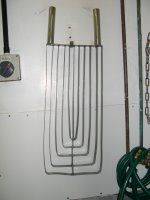
Nick coaches me on how to dip the harp into the vat and carefully drag it through the milky jelly. When you get to the end of the vat, you rotate the harp and drag it back the other way. This is repeated back and forth as you work your way across the vat. Then you must cut the curd perpendicular to the original cuts. This makes nice, little cubes that must be left to sit and begin to release whey. The metal covers are placed on the vat. Timer is set and we go into the other room to scrape blue cheese. Back to the vat and it is time for the second cut. This time I start from the center and draw the harp towards me. I do this all around the vat. Vat is covered and timer is set again. Back to scraping. A few minutes later we're back. Time to stir the curds. I roll up my sleeves and scrub like I'm preparing for surgery. Now I get to truly test my grit. I plunge my arms into the vat and start to stir the curds with my arms and hands. The cheese harp misses a few curds so I break up large curd with my fingers. Nick says, "I don't know how you could do it any other way. If you don't stick your hands in it, you can't tell what the curds feel like." These curds feel amazing. It is like sticking your hands into soft, warm, pudding. The curds gently dance across your arms and swim in the whey as you paddle your hands through this mass of coagulated milk. Your face is just inches from the surface. It smells sweet and delicate. I could do this all day. It is very soothing on my skin. I bet it would make a terrific substitute for a mud bath. Hmmm. I see a potential sideline, here. Nick makes me stop. He agrees, stirring the curd is the best part of the job.
The curd settles and it is time to make cheese. Nick sets up a baffle to keep the curd from flowing out of the tap at the base of the vat. Whey is drained into a tub with a suction device on it. It goes out into a pair of whey tanks. The whey is later fed to happy pigs. As the level lowers in the vat, I begin to scoop the curd into a tub. I shuttle the tub back and forth while Nick fills the moulds. We quickly fill thirty moulds with fresh cheese. Nick gives them all a flip and we're done. The entire process takes about four hours from pasteurization to a thirty filled moulds. We clean up and have a late lunch
Gotta finish up the big scrape in the afternoon. We clean up and lock up. I'm on cloud nine. I got to make cheese today!!!
Went back to the Royal Seven Stars Hotel. It is curry night! 7.95 and all the curry you can eat. It was ok. Not the best, but it went well with my half pint of Heron Valley organic cider. I cleaned my fingers and pulled out my laptop. The WIFI was free, but it was a very low signal and it kept failing. Grrr. So I'm back home using the dial up connection. Oh well. I tried. At least I had an inexpensive supper.
Posted by
Sairbair
at
3:52 PM
0
comments
![]()
Labels: Ticklemore Cheese Devon England
Training continues at Ticklemore

Monday, September 4th, 2006
This is my second week at Ticklemore. I'm starting to key into the rhythm of the work day. The day begins by pulling out index cards that are made for each cheese currently in production. The card will indicate what each batch of cheese needs, be it dry salting for the first time, dry salting for the second time, turning or moving into the cave if it is Ticklemore Goat, spiking the blue cheese. Ben usually starts pasteurizing the cow's milk for Devon Blue, so he's busy running around moving the milk from the storage tank to the pasteurizer and monitoring the temperature very closely. Everything must be absolutely clean or else you'll get contaminated milk and bad cheese.
Since we don't make cheese on Sunday, we don't need to turn any cheese in the make room. This leaves us free to do everything else. I am kept busy salting several batches o Harbourne and Devon Blue.
We break for tea and relax in the apartment. With Kay's departure, we're one person short. I can really feel her absence. We don't get the work done as quickly as before. We go back and I start doing the dishes. I'm called in to help make the Devon Blue. Today I am the mule. I scoop the curds out of the vat and plop them onto the making table. Nick and I then gently break up the large clumps so they resemble scrambled eggs.
I scoop several batches while Ben is in the other room getting the goat's milk ready in the pasteurizer. He joins us and I hand the scooping over to him. I'll prepare the curd to go into the moulds and Nick fills the moulds to just below the rim. When he has about six mould filled with curd and they've shrunken in size, he'll combine one mould on top of the other. They'll shrink so much that the two halves will settle into just one mould within a couple of hours. One vat of 212 gallons of milk will wind up making about 30 Devon Blues. Cow's milk has about a 12% yield for cheese. Goat's milk is 10%. Ewe's milk has the highest yield. I can't remember how much, but I think it is closer to 15%.
I really want to return when they're working with sheep's milk. It is a very thick milk and has a different texture from the other two milks that Ticklemore uses. Unfortunately (or fortunately,) sheep only produce milk for six months out of the year. Ticklemore quits making Beenleigh in late July, when their supply literally dries up. Perhaps I should come back in the spring to learn how to make Beenleigh and Boyton, the sheep's milk equivalent to Ticklemore Goat. Boyton is a fantastic cheese. It is nutty and faintly sweet. It has a texture like a sheep's milk cheese from the Pyrenees Mountain. There is a springiness in its texture and a creaminess on the palate. The texture comes from the size of the curd and the fact they wash the curd in warm water. This is a cheese I'd love to try to make myself. They only make a very small amount of it because most of the sheep's milk goes into their Beenleigh Blue. By the way it's pronounced BEAN-lee. Like: been there, Vivian Leigh. I'd love to take some Boyton home to share.
The small round vat is prepared for Ticklemore Goat. A separate, five gallon tub is filled with more heated goat milk. This is for their bloomy rind buttons to sell in town at the cheese shop. Rennet is added and it is left to set up.
Time for lunch.
After lunch we make Ticklemore. Nick cuts it with a paddle shaped cheese harp. He uses and arch pattern and goes around the vat. The gel like curds, immediately start to release whey and begin to sink. He leaves it to sit for a while and returns to stir it. Stirring helps break up the curds even more and they keep shrinking. He hands me the paddle and says, "Alright, give it a go!" I stir the curds using a rowing motion. Nick says, "It's like sculling." I say, "It's like canoeing." We stir all around the vat, keeping the curds moving for a few minutes. Nick takes over again and I go back to cleaning. Over half of cheesemaking is cleaning and doing dishes. Never a dull moment.
I'm called back over and it is time to make Ticklemore. Ben scoops the curd, I salt the curd and work it into the curds, and Nick and I fill the moulds. Nick then turns the freshly filled moulds to keep them draining well. We wind up making 16 Ticklemore Goats in the end.
We finish the day cleaning everything up, scrubbing down the floors and sinks and locking the door.
I spend the rest of the afternoon prepping for my Mexican dinner. I've got tostada fixings! Yum. Sarie doesn't have any ground cumin or coriander, but there are seeds of both in the cabinet. There is also a mortar and pestle. OK, I'll grind my own. I feel very proud, as I crush the fragrant seeds into a fine powder. I get everything ready and start browning my ground turkey, or as they call it, minced turkey. I add my seasonings and cook it a little more.
Dinner must wait because I need to take care of the infant cheeses. I clean up and change into my dairy gear. After scrubbing, I enter the Making Room where the fresh cheese is merrily draining. I begin flipping the 10 Harbourne Blues that Nick and Ben made. I move onto the 16 TG's. I finish with the 30 Devon Blues. I always work with the goat's milk cheese first and cow's milk cheese last due to issues with lactose sensitivites. Many people can't tolerate cow's milk, so this is an extra precaution on our end.
Posted by
Sairbair
at
3:41 PM
0
comments
![]()
Labels: Ticklemore Cheese Devon England

